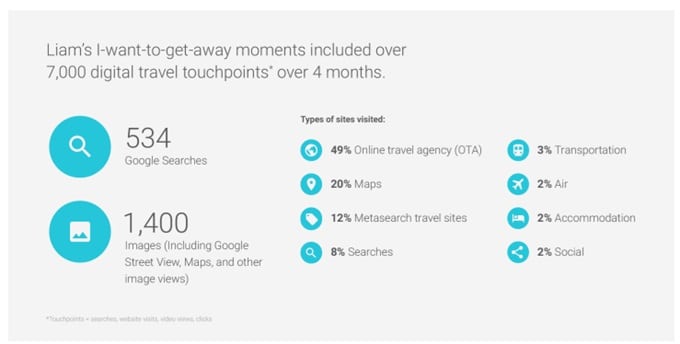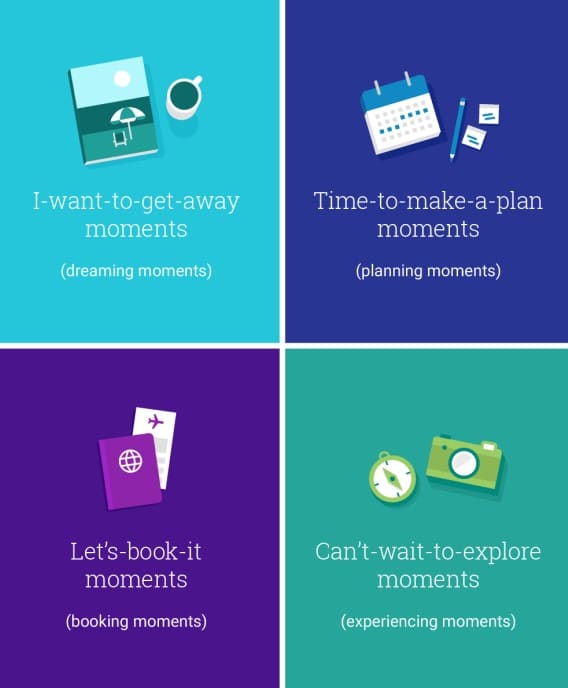Being There on the Traveler’s Path to Purchase
I was very intrigued 9 years ago when Google Think teamed up with Luth Research ZQ Intelligence™ to study in-depth, the customer journey online – the path to consumer fulfillment.
Because most marketers lacked the data and acumen (and still do) to understand the customer buying journey, it was a study long overdue. Google undertook it because they were trying to promote mobile advertising and push Google mobile ad demand.
We’re happy to enjoy the insights, and as travel marketers we don’t want to deny the incredible reach of Google ads and their powerful targeting capabilities. The right ad at the right time is a key part of mastering the decision touchpoints of consumers.
Interestingly, the reality of smartphones is that consumers tend to dabble more at research and topics rather than doing it all at one sitting on a desktop or laptop computer. This fragmentation of the full customer journey actually expands opportunities to reach consumer touchpoint opportunities with unique experiences and more frequent visibility.
Yes, AI is trying to give travel consumers one result for a search, but given each travel search users have personal goals, values and habits, it’s doomed to failure. If a user wants lots of good-quality results to review, then Google’s one answer for one query is not a great approach for them for ad revenue or user satisfaction.
And I like how (in their report) Google refers to online visibility as “share of consumer intent.” Because every second on the Google search engine is about the traveler’s intent to find fulfillment. There are many ways to fulfill it.
Introducing Microments: Intent-rich Moments when Someone Acts on a Need
They introduced the concept of micromoments which were key decision points from solution discovery to research to product choice commitments. Of course, they were able to do this at a scale and depth which illuminates many points of insight.
And these insights are valuable whether you’re selling property management software, International travel tours, or travel management software or anything else.
The concept is really about how consumers make decisions at key points which are intent-rich moments when someone acts on a need. If you can sync with them in those moments with them, you’re being there and thus more likely to create a customer.
Be There and Be Helpful!
Google Think’s advice was simple: Be there and be useful at key decision points and you’re putting yourself in the driver’s seat to capture a new customer.
And when they say “micromoments” they’re not kidding. In many cases, the travel consumer had 5,000 to 7,000 touchpoints over months of considering and researching their travel plans. This suggests that travelers aren’t certain and need better guidance about their travel plans.
Obviously, a marketing page or blog post isn’t going to get the job done, nor is mastering one touchpoint. Instead, it’s about publishing a purposeful, continuous stream of useful content in images, text and video that generates impact and engagement. It isn’t about scheduling, but rather timing to their search activity. And since this is a lengthy engagement, branding is important. Trust takes time.
You can have all the traffic in the world, with the best value proposition possible, but if you’re not connecting optimally at those touchpoints in their buying journey, you can miss the sale. This is a practical, tactical matter of connecting better. With this insight, you might command every customer touchpoint with more relevant content, significant commentary, emotional effects and then promotions that really hit home each time — more touchpoints with more impact and significance to them.
67% of travelers are more likely to book with a travel brand that provides relevant information for the destinations they’re interested in. — from Google/Ipsos Connect, travel playbook omnibus.
This sympatico between your brand and the customer weighs on your brand’s ability to be “the only provider for them” objective and that of course makes competitors disappear.
Google Think does talk about relevance, and perhaps significance, but not so much about the exclusivity of “disappearing your competitors”, so they’re missing out on the greater goal of impacting and creating intense loyalty. Call it stickiness or whatever you want, that magnetism has value. Dissolving the view of competitors is the ultimate success of content strategy.
Micromoments in the Traveler’s Journey
And in 2016, they published some articles on the path to purchase of travel consumers. What’s so illuminating about it is the number of opportunities for any company to reach them during this buying experience — thousands of touchpoints.
For example, here is the story of just one traveler where searches are frequent.

And Google Think revealed too, that travelers aren’t so brand loyal. And if they aren’t then they’ll be heading to Google search or YouTube for ideas.
They’re practical focused in on unique features and benefits — personally relevant only to them. This means the major travel portals with their general, public packages might be too generic. Travelers want to feel special, not loaded like sheep into a plane or ship.
Their project’s insights can greatly help our quest to:
- understand the traveler’s path to purchase
- give us a framework for deeper and more practical insights for strategy and tactics
- help us be there at those customer micromoments with the right messaging, path and offer
The Micromoment Phases:
- I Want To Get Away – this is the dreaming phase where the mind travels first to imagine and explore the experience and the intense personal and emotional benefits of a trip.
- Time to Make a Plan – time-to-make-a-plan moments are when people turn to a device, setting the wheels in motion for the travel research process. Top things travelers look for in these particular micro-moments include prices, hotel reviews/pictures/cost/availability, flight length, travel schedules, and activities in the destination such as tours, attractions and events.
- I Want to Buy – perhaps the most important micro-moment, where travelers put their dollars behind their decisions.
- I Want to Make the Experience the Best Possible – the post-purchase period where travelers are ready to get out and see their destination.

Developing Your Micromoment Plan
Each business has unique target audiences and opportunities to match unique product offerings. Your digital marketing audit should respond to this in-depth so your SEO and Content strategy are focused on this essential opportunity.
To respond to your micro-moment opportunity, you should follow some steps:
- know your personalized, significant unique value proposition
- know your target audience
- discover and map out major consumer touchpoints for their travel experience
- map out consumer touchpoints and how your content will intersect with them
- map out how you will persuade them at each touchpoint and what your next suggested step is
- map out your keyword and SEO strategy so you’re visible at important searches on their journey
- build out and refine content to peak on their touchpoint decisions
- reshape the brand they will see on your site to reaffirm your commitment to each touchpoint decision they have to make
- enhance your content with images, color, video and storytelling that focuses on touchpoint decision-making
Of course, each customer’s timeline is unique and basic canned approaches might not be good enough. No plan is perfect, and you’ll need A Grade analytics to help you understand what’s happening on your site. Without excellent analytics, you’ll be in the dark.
You don’t need market-leading analytics all the time. Basically, subscribe to the solution month-to-month until you gain these critical insights and then you can cease the subscription (given they are expensive).
It’s going to be a big project for you and I hope I might be a key part of your journey to success — from omnipresence on Google to building rich, helpful and satisfying content for your users.
Contact me at 416 998 6246 to discuss your next project.
Travel Marketing | Tour Operator Marketplaces | Travel Management Software | SaaS Marketing | Travel Marketing | Business Travel | Travel | AI Marketing Software | Maldives Travel | Property Management Software | Revenge Travel Trend | Joy of Travel | Rocky Mountaineer Train Tours | Wine Travel Marketing | Mountain Bike Marketing | Google Finance | Advanced SEO | Outsourcing Marketing

